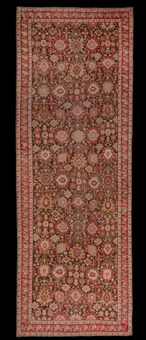Antique handmade oversize carpet No. 59445 Karabagh, ca. 1910 Caucasus 597 x 213 cm

Larger images (will open in new window)
Please click on the thumbnails below for a larger view
| main view |
close-up |
2nd close-up |
 |
 |
 |
| Item Number: |
59445 |
| Name: |
Karabagh, ca. 1910 |
| Country of Origin: |
Caucasus |
| Size: |
597 x 213 cm |
| Made:
|
ca. 1910 |
| Pile: |
wool |
| Design: |
floral and geometric / medallion |
| Ground Color: |
brown |
| Remarks: |
This is a unique handmade / hand-knotted / traditional oriental carpet
The pile of this carpet is made of wool
This carpet is in good condition despite its age |
 add to cart
add to cart
More about the provenance Karabagh, ca. 1910 | Caucasus
Karabagh is located in the Russian part of Azerbaijan and is therefore part of the Caucasus region. Karabagh is actually the name of a mountain area (with black soil). It has been under Persian reign repeatedly. The population mainly consist of Armenians, settled down Turk peoples and Russian immigrants. The Karabagh area has been influenced heavily by near-by Turkey in the quantity of rugs being made. One typical characteristic of Karabagh rugs is a soft brick-red (also being called Karabagh-red among carpet experts). The designs often resemble the Persian Farahan (Feraghan). Newer production of Karabagh rugs is rather rare, there are mostly old and antique Karabagh rugs found in the market.
This is an Oriental nomadic rug. The word "nomad" comes from the Greek word "nemein". Nomads are wandering tribes, shepherds, stockbreeders, or hunters. In the minorly populated areas of Asia and North Africa they move with their herds, all their belongings and their tents to new places constantly. Many states already tried to make them settle down with various success. Mostly it is the women of the tribes which contribute to the family's income with their carpet knotting and weaving while the men breed stock or go hunting. But due to the circumstances of nomadic life the carpet production often lacks regularity and precision in form and design, which actually adds to their originality and makes them even more popular. The wool is mostly dyed with vegetable dyes.

